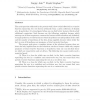Free Online Productivity Tools
i2Speak
i2Symbol
i2OCR
iTex2Img
iWeb2Print
iWeb2Shot
i2Type
iPdf2Split
iPdf2Merge
i2Bopomofo
i2Arabic
i2Style
i2Image
i2PDF
iLatex2Rtf
Sci2ools
109
Voted
ALT
2001
Springer
2001
Springer
Learning How to Separate
The main question addressed in the present work is how to find effectively a recursive function separating two sets drawn arbitrarily from a given collection of disjoint sets. In particular, it is investigated when one can find better learners which satisfy additional constraints. Such learners are the following: confident learners which converge on all data-sequences; conservative learners which abandon only definitely wrong hypotheses; set-driven learners whose hypotheses are independent of the order and the number of repetitions of the data-items supplied; learners where either the last or even all hypotheses are programs of total recursive functions. The present work gives a complete picture of the relations between these notions: the only implications are that whenever one has a learner which only outputs programs of total recursive functions as hypotheses, then one can also find learners which are conservative and set-driven. The following two major results need a nontrivi...
Related Content
| Added | 15 Mar 2010 |
| Updated | 15 Mar 2010 |
| Type | Conference |
| Year | 2001 |
| Where | ALT |
| Authors | Sanjay Jain, Frank Stephan |
Comments (0)

